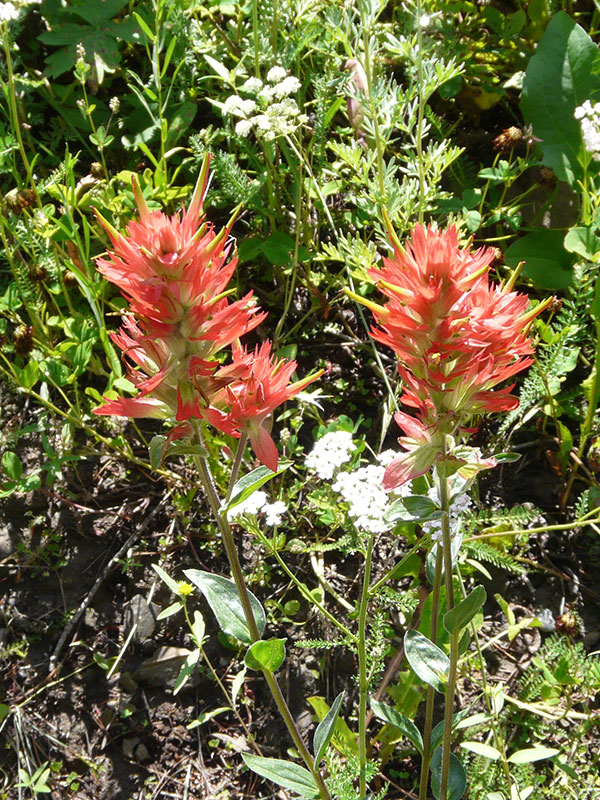Castilleja spp. / paintbrushes
- vibrant, red (or yellow) inflorescence (bracts)
- widespread, but confusing… five or more species in the area
See also: Castilleja covilleana / Rocky Mountain paintbrush, Castilleja linariifolia / Wyoming Indian paintbrush, Castilleja miniata / scarlet paintbrush, Castilleja spp. / two yellow paintbrushes
Note: mostly, this is about red paintbrushes but there are also yellow ones. Every thing I say about red ones is true about the yellow ones as well (except for the color).
From shortly after snowmelt through August (at least), the Indian paintbrushes are one of the happiest sights throughout the Valley. Their bright coloration is an immediate eye catcher and very difficult to miss. In many habitats, their appearance in early spring is made possible by their biennial or perennial life cycle.
Other than that, the plants in the genus Castilleja are weird and wonderful in many ways. First off, while calling the paintbrush itself a “wildflower” is fine, what catches your eye immediately isn’t actually a flower. The red (or yellow) bits are actually modified leaves, bracts. The flowers themselves are in the axils of the bracts (see the gallery photos).
Second, it seems that all the members of this genus are hemiparasitic, meaning that they are parasites, but not complete ones. They get nutrients and other substances from a host plant but also have green, photosynthetic leaves. They also reproduce by seed and use insects or hummingbirds as pollinators.
While it is possible to grow paintbrushes from seed (collected as soon as the pear-shaped fruit capsules turn brown), they won’t grow in the absence of a host plant. Suitable hosts locally include various grasses, blue penstemon or blue-eyed grass (Sisyrinchium idahoense). Given that different species grow in habitats with dominant trees or shrubs (willows, sagebrush), it seems like those should be hosts, but I have no information that they actually are.
The problem, however, is that there are a lot of Indian paintbrushes, 40 listed on the Idaho Fish and Game site, and even if they are not all red, enough of them are to make their identification somewhat difficult. In our area, there are at least 3 red ones. I find that the leaves are helpful in separating them. The same can be said of the (at least) two yellow species.
The main thing I have learned in my attempts to sort these out is – Take Another Picture! It may not be until you get home that you find out that leaf structure matters, or that some are hairy and some not, or that some grow in clumps and some not, or that some red species are occasionally yellow, or… You get the idea. Some, I have found way high, and I was tired. I didn’t take that extra photo but I wish now that I had.
In any case, there are 3 red and 2 yellow species on the site. I may have identified them correctly; I hope so, but no guarantees. But regardless, besides the hemiparasitism and the arrangement of bracts and flowers, there is at least one other interesting bit.
Interesting bits – Indian paintbrushes in general are considered selenium accumulators. This is a mixed bag… selenium is a necessary nutrient for animals, but only in small amounts. Thus selenium accumulators tend to be toxic to grazing animals and humans who eat them. Right now (to me) it is unclear if the paintbrushes are selenium “indicator” plants (i.e. limited to areas with high selenium in the soil – like Idaho), or simply “facultative” accumulators (i.e. they accumulate it but don’t have to have high levels to grow).
| Color | |
|---|---|
| Family | |
| Blossom size | |
| Inflorescence size | |
| Inflorescence type | |
| When? | |
| Where? |
